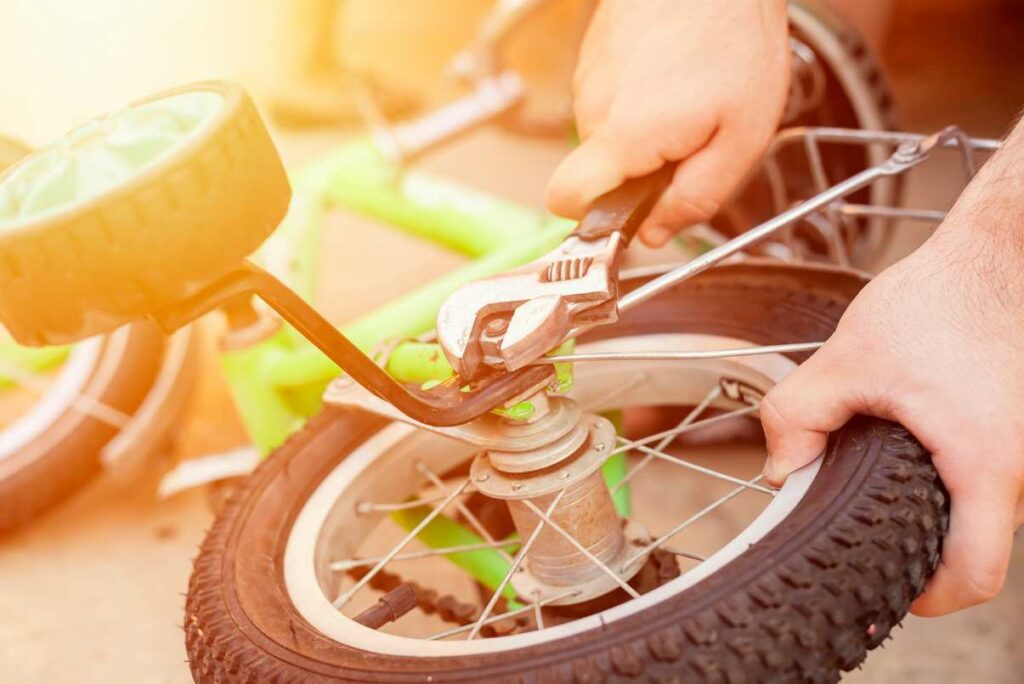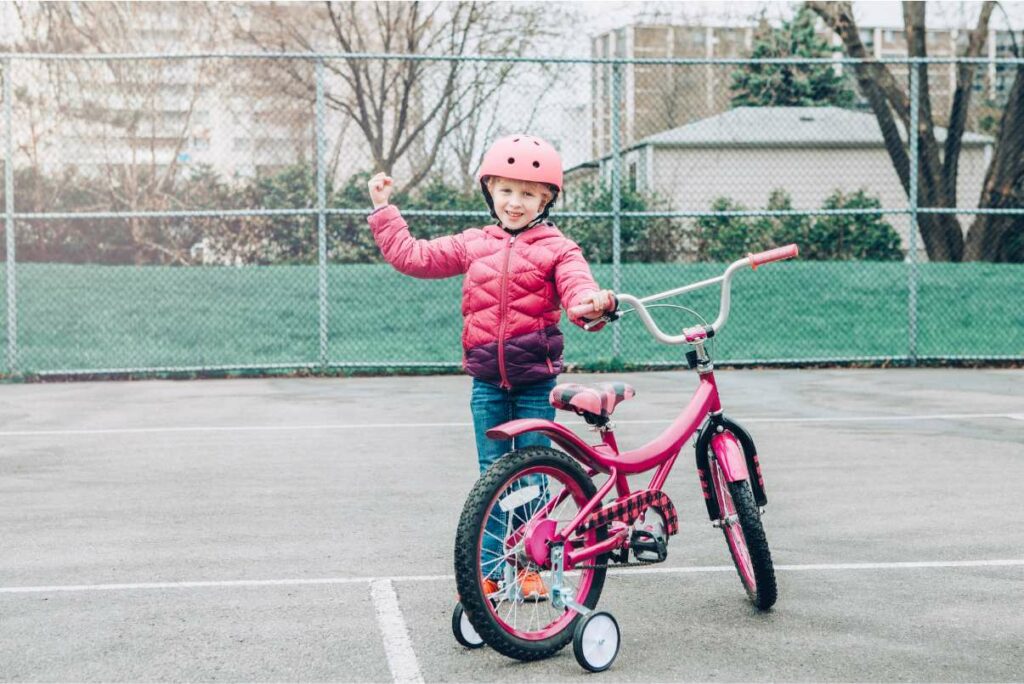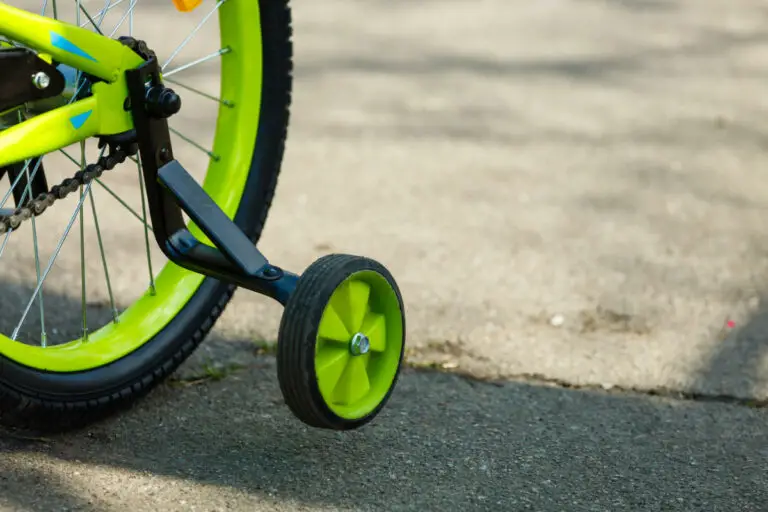What Are Training Wheels – Benefits and Drawbacks

Training wheels, often referred to as stabilizer wheels or balance wheels, are small auxiliary wheels that can be mounted to a bicycle to assist a rider in learning to balance on two wheels.
Typically used to educate young children or beginners on how to ride a bicycle, training wheels are designed to offer the rider more support and stability as they learn to balance and pedal.
This article will examine the different features of training wheels, including how they function, their advantages and disadvantages, and how to use and maintain them effectively.

How Training Wheels Work
Typically, training wheels are mounted to the rear axle of a bicycle and adjusted to a height that enables the rider to retain balance and stability while seated.
When the bicycle leans to one side or the other, the training wheels come into touch with the ground and serve to stabilize the bicycle.
Training wheels are intended to provide brief training help while a rider learns how to balance and pedal.
As the rider gains comfort and confidence on the bicycle, the training wheels can be gradually lowered or eliminated, allowing the child to learn to balance and ride independently on two wheels.
Benefits of Training Wheels
For young riders and beginners learning to ride a bike, training wheels can offer a variety of advantages. Among the key advantages are:
- Safety: For riders who are still learning to balance and pedal independently, training wheels can add an added degree of protection. Training wheels can assist reduce falls and injuries while the rider is still getting the feel of biking by adding more stability and support.
- Confidence: Young riders who might be reluctant or terrified to ride on two wheels can gain confidence by using training wheels. Training wheels give riders a sense of security and stability, which can boost their confidence while riding and help them become more at ease and at ease with their balance and pedaling speed.
- Ease of use: Training wheels are simple to use and install, making them a practical and hassle-free aid for anybody learning to ride a bike. As the rider develops their biking skills, they may be adjusted to the right height and are simple to attach to most bikes.
Drawbacks of Training Wheels
Although using training wheels can be beneficial for learning to ride a bike, there are certain disadvantages to take into account:
- Delays in learning to balance: Training wheels have the potential to hinder a rider’s ability to learn to balance on two wheels, which is one of their main downsides. Riders may rely on training wheels too much and fail to build the muscle power and balance necessary to ride independently on two wheels because they add extra support and stability.
- Might not be suitable for all bikes: Training wheels might not be appropriate for every style of bike, especially ones with a low profile or smaller wheels. In these circumstances, the training wheels might not offer sufficient clearance or stability, which might lead to the bike toppling over or becoming unstable.
- Can be heavy: Training wheels can be heavy and add extra weight to the bike, making it more difficult to ride and control. Younger riders may find this particularly tough because they may find it difficult to control a bike with training wheels.

Using Training Wheels Effectively
To maximize the benefits of training wheels, it is essential to utilize them correctly and responsibly. Here are a few guidelines for efficiently using training wheels:
- Start at the right height: Begin at the proper height: Adjust the height of the training wheels so that the rider can retain balance and stability while seated on the bicycle. The wheels should be positioned so that, when the bicycle leans to one side or the other, they barely contact the ground. If the training wheels are set too high, the rider may not receive sufficient assistance, and if they are set too low, the rider may have trouble pedaling.
- Gradually lower the wheels: As the rider gains comfort and confidence, the training wheels can be progressively lowered to provide less support. This can help the rider gain the necessary balance and muscle strength to ride independently on two wheels.
- Encourage independence: While training wheels can provide a sense of security and stability, they should be used to foster independence. It is crucial to encourage the rider to balance and peddle as much as possible on their own. This can help the rider develop the necessary abilities and confidence to ride freely.
- Monitor progress: It is essential to evaluate the rider’s progress and modify the training wheels accordingly. If the rider has difficulties maintaining balance or pedaling, the wheels may need to be slightly lifted to provide additional support. If the rider’s performance is satisfactory, the wheels can be lowered to provide less assistance.
Maintaining Training Wheels
Training wheels must be properly maintained to function effectively and provide essential support and stability for the rider. Here are a few maintenance guidelines for training wheels:
- Regularly check the wheels: It is essential to inspect the training wheels on a regular basis to verify that they are correctly mounted and in good functioning condition. Ensure that the wheels are properly tightened and do not wobble or come loose.
- Inspect the wheels for wear: Training wheels can deteriorate over time, especially if they are used regularly or on a rough surface. Regularly inspecting the wheels for signs of wear, such as cracks or chips in the plastic or metal, is essential. If the wheels are damaged or worn, replacement is necessary.
- Lubricate the wheels: Training wheels should be greased on a regular basis to prevent binding and sticking. This can assist extend the life of the wheels and guarantee that they provide the rider with essential support and stability.
In conclusion, Training wheels are a helpful tool for teaching young riders and beginners how to balance and peddle a bicycle.
While they might provide a sense of security and stability, it is crucial to encourage the rider to develop the skills and confidence necessary to ride freely on two wheels.
Additionally, adequate maintenance is required to guarantee that the training wheels provide essential support and stability to the rider.






